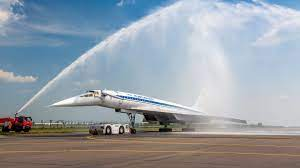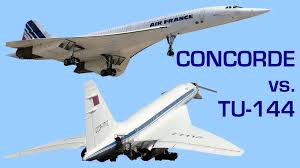Tupolev Tu-144 vs Concorde When it comes to the history of aviation, few aircraft capture the imagination like the supersonic passenger jets. Two names stand out in this category: the Soviet Union’s Tupolev Tu-144 and the Anglo-French Concorde. Both were marvels of engineering in their time, designed to whisk passengers across continents at speeds faster than the speed of sound. But how do these two legends compare? Let’s dive into the fascinating world of the Tu-144 and the Concorde.

The Birth of Supersonic Travel
The idea of supersonic passenger travel took off in the 1960s. The goal was simple yet ambitious: to cut travel times drastically by flying faster than the speed of sound (Mach 1). Both the Soviets and the British-French consortium wanted to be the first to achieve this, leading to the development of the Tu-144 and Concorde.
Tupolev Tu-144 vs Concorde Design and Development
Tupolev Tu-144:
- The Tu-144, designed by the Tupolev Design Bureau, made its first flight on December 31, 1968, just two months before the Concorde.
- It was the world’s first commercial supersonic transport aircraft.
- The design featured a delta wing configuration and a retractable canard for improved control at lower speeds.
- The Tu-144 was capable of reaching speeds of Mach 2.3 (about 1,520 mph).
Concorde:
- The Concorde, developed by a British-French collaboration between Aérospatiale and the British Aircraft Corporation, first flew on March 2, 1969.
- It was designed with a sleek, streamlined delta wing and a slender fuselage.
- Concorde could cruise at speeds of Mach 2.04 (about 1,354 mph) and had a maximum range of around 4,500 miles.
- The aircraft was renowned for its elegant design and luxury.
Performance and Operations
Tupolev Tu-144:
- The Tu-144 faced several technical challenges and safety issues during its development.
- It entered commercial service in 1975 but was plagued by reliability problems and high operational costs.
- A major setback occurred in 1973 when a Tu-144 crashed at the Paris Air Show, raising serious safety concerns.
- The aircraft was eventually retired from passenger service in 1978 after just 102 commercial flights.
Concorde:
- Concorde had a more successful operational history, entering service in 1976 and continuing to fly until 2003.
- It was operated by British Airways and Air France, offering transatlantic flights primarily between London and New York.
- Concorde was famous for its luxury, with passengers enjoying gourmet meals and top-notch service.
- Despite its success, Concorde was retired due to high operating costs, noise restrictions, and a tragic crash in 2000.

Tupolev Tu-144 vs Concorde Passenger Experience
Tupolev Tu-144:
- The Tu-144 offered a less luxurious experience compared to Concorde, with more focus on function over form.
- Passengers experienced a noisier cabin due to the aircraft’s engine design.
- The overall passenger experience was more utilitarian, reflecting the Soviet approach to air travel at the time.
Concorde:
- Concorde was synonymous with luxury and exclusivity.
- Passengers enjoyed a quieter, more comfortable cabin with spacious seating and personalized service.
- The experience was tailored to high-end travelers, making it a symbol of prestige.
Tupolev Tu-144 vs Concorde Legacy and Impact
Both the Tu-144 and Concorde left a lasting legacy in aviation history. The Tu-144, despite its short service life, was a testament to Soviet engineering prowess and ambition. It paved the way for future advancements in aerospace technology.
Concorde, on the other hand, became an icon of aviation, representing the pinnacle of commercial air travel. Its sleek design and impressive performance captured the public’s imagination and set a standard for luxury air travel that remains unmatched.
Conclusion
The Tupolev Tu-144 and Concorde were both incredible achievements in the history of aviation. While the Tu-144 struggled with technical and operational challenges, the Concorde enjoyed a longer, more successful career. Both aircraft, however, pushed the boundaries of what was possible in commercial aviation and left an indelible mark on the industry. Today, as we look to the future of supersonic travel, we remember the lessons learned from these pioneering jets and continue to dream of faster, more efficient ways to connect our world.
FaQs
What were the main differences between the Tupolev Tu-144 vs Concorde
Which aircraft flew first, the Tupolev Tu-144 vs Concorde?
Why was the Tu-144 retired from service so quickly?
What was the cruising speed of the Concorde?
Which airlines operated Concorde?



